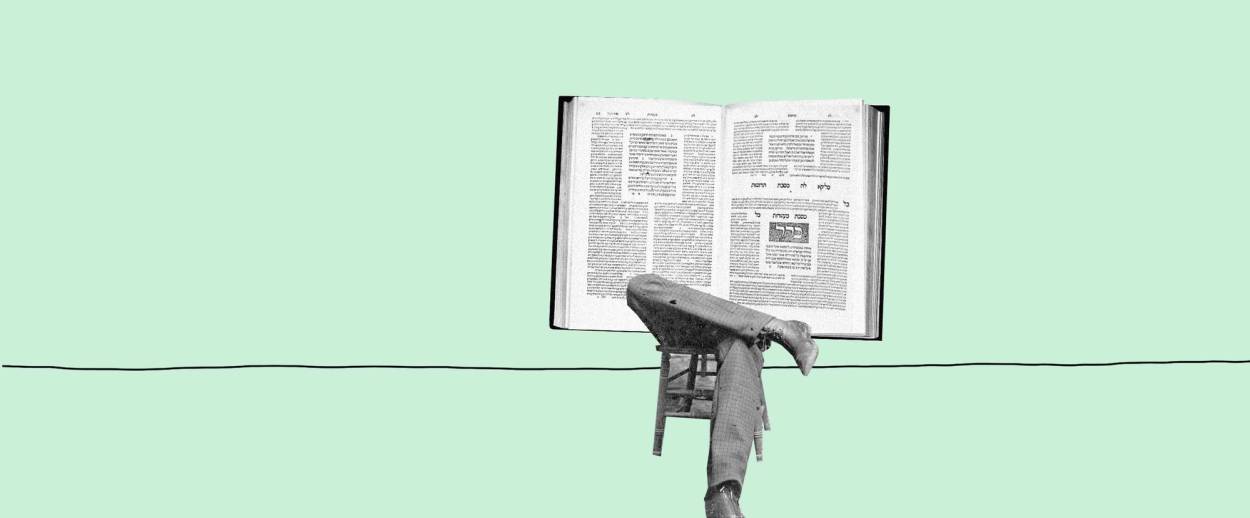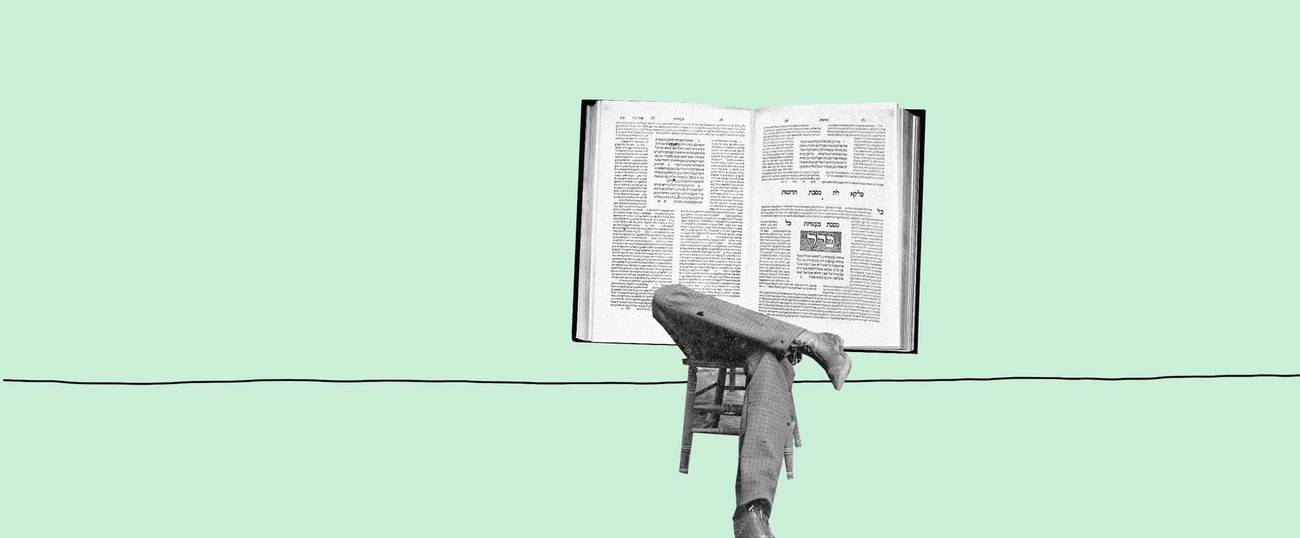The Talmud, Personified
In his new ‘biography,’ professor Barry Scott Wimpfheimer argues that the Talmud is more important now than it has ever been




The cover of Barry Scott Wimpfheimer’s new book The Talmud: A Biography features a work of feminist protest art that resembles a rainbow tapestry shading from red to blue, composed of thousands of small pieces of paper rolled up intro scrolls. Each of those pieces of paper is a small section of a printed Talmud page. The work, created in 2010 by American-Israeli multimedia artist Andi Arnovitz, is titled If Only They Had Asked Us. As Arnovitz writes on her website, “The piece suggests that had women been involved in helping to write these books, the laws would be far more colorful and vibrant.”
This piece of art is one of the many approaches to Talmud that Wimpfheimer considers in his book, which is part of Princeton University Press’ series Lives of Great Religious Books—a collection of more than a dozen books that also covers the Book of Mormon, the Book of Job, and the Bhagavad Gita. “As soon as I heard about this series, I knew I wanted to write about the Talmud,” Wimpfheimer, a professor of Talmud at Northwestern University, told me in a telephone conversation. “The Talmud really lends itself to a biography because it’s had various many periods of existence, and it has lived in various types of ways, and it continues to live in various types of ways: There is the text as it is interpreted and understood in quite different ways and the symbolic register of the Talmud having meaning beyond the meaning of the words inside it. The Talmud can mean so much beyond what is contained within it.”
Wimpfheimer’s biography is focused less on what the Talmud contains and what it says, and more on how the Talmud has been read and what it has come to mean. “My premise at the outset was that I would embrace the conceit of biography and try to pretend the Talmud was a person, and identify those moments when the Talmud is personified and embodied in its history,” Wimpfheimer explained. “Along the way, though, I came to realize that whenever I have encountered things like the medieval disputations, or the contemporary Korean fascination with the Talmud, I have dismissed these things as not really important and relevant, because the actors involved don’t know the Talmud like I know the Talmud. They don’t understand it in a deep way. In my head, I dismissed that as not the Talmud. But I began to realize that so often when the Talmud was personified and embodied, it did so in this symbolic register. Thus biography might be the ideal way to articulate this register.”
Unlike most introductions to the Talmud, Wimpfheimer’s book does not include an overview of the range of topics covered in the Talmud, nor does it systematically lay out the various historical layers of the text. Rather, it considers the Talmud as a work of religious literature produced at a particular historical moment (what Wimpfheimer terms the “essential Talmud”) while also examining how the Talmud became the central canonical work of the Judaism that emerged after the destruction of the Temple (what he calls the “enhanced Talmud”), and why it serves as “the ultimate symbolic representation of Judaism, Jewishness, and Jews”—what he refers to as the “emblematic Talmud.”
In his section on the essential Talmud, Wimpfheimer tries to convey the experience of studying Talmud by focusing on two particular passages of Talmudic text, one more legalistic—about liability for the damages caused by starting a fire—and one more literary, about how Israel came to accept the Torah at Sinai. He explains these passages in depth and then, in his section on the enhanced Talmud, he demonstrates how they have been understood by various commentators over time—thus offering an introduction to the classical medieval commentators as well as to Jewish philosophy and to Kabbalah. He distinguishes between traditional readings of the Talmud, in which the Talmud is taken at face value as the record of a historical conversation among the rabbis featured in its pages, and critical readings, in which the Talmud is a literary construct designed by a set of active anonymous redactors to resemble a conversation among those rabbis. Although he omits his own biography from this biography, Wimpfheimer is no stranger to either approach.
“As a child, I used to memorize Mishnah, about a hundred mishnayot a year from third grade to seventh grade,” Wimpfheimer told me, reflecting on his upbringing in a traditional Orthodox yeshiva background in Washington Heights, New York. His Talmud study was “traditional”—without any critical methods—until he graduated high school and came to study at a yeshiva in Israel, where he encountered a teacher, Shmuel Nacham, whom he describes as “the first to show me a historically responsible presentation of the Talmud,” recognizing that the Talmud is a historical text with different layers of discourse. At the time he was not able to appreciate how much Rabbi Nacham’s approach had in common with the methodology of academic Talmud critics, but he knew he had found something that spoke to him. “The intellectual satisfaction of studying Talmud on this very deep level is something I fell in love with and enjoyed. So even though I was a double major in math and history at Columbia, I would spend six hours a day studying Talmud because it was my passion.”
Wimpfeimer went to rabbinical school after college because “I thought rabbis were scholars, and that this was what scholars of Talmud did,” but the ministerial aspects of the job were not for him. He realized that the way he was approaching Talmud had so much more in common with the way academics study the text than with the way Talmud is traditionally studied in yeshiva settings. And so he got his Ph.D. in religion from Columbia with David Weiss Halivni, a Holocaust survivor and one of the leading Talmud scholars in the world, and since then he has been teaching Talmud in American universities. As one of his colleagues, professor Moshe Simon-Shoshan of Bar Ilan University told me, Wimpfheimer “is one of the few Talmud scholars out there who combines traditional erudition and philological rigor with a sophisticated knowledge and understanding of modern literary and critical theory.”
Wimpfheimer teaches an online introductory Talmud course and his passion for his material is infectious. But in this book, he is trying to reach an audience beyond those interested in the mechanics of how to study Talmud. “I wanted this book to be something that you could give to someone who has never read the Talmud, perhaps has heard of it and knows that it is associated with Jews, but doesn’t know much more. I was trying to produce a book that made a case for why the Talmud has been important, continues to be important, and in some ways is more important now than it ever has been. I wanted to show the way the Talmud has influenced legal theory, comedy, nonfiction writing. I’m trying to give a deeper sense of the thick relationship the Talmud has had with Jewish culture more generally and producing some of what we associate as Jewish intellectual culture.”
Wimpfheimer focuses on the Talmud’s cultural import in the third section of his book, on the Talmud’s symbolic or “emblematic” meanings. He shows how some of the Talmud’s most virulent opponents were responsible for making the text most culturally significant—from the Karaites’ sectarian rejection of rabbinic Judaism in the ninth century to the medieval Christian tribunals that burned and banned the Talmud to the Enlightenment critique of the Talmud as antithetical to modernity. “So many different factions have needed to push against the Talmud in order to establish themselves: Hasidim, Zionists, Frankists. The Talmud came to represent something to them that they wanted to distance themselves from. That is an interesting indicator of the Talmud’s cultural power. But even more fascinating is the reclamation that comes after. Once they establish themselves, they come back to the Talmud and reclaim it an engage it,” he said, citing the burgeoning interest in Talmud study among secular Israelis like Ruth Calderon. “This represents the Talmud’s incredible flexibility. That process of reclamation and rediscovery is very exciting about the Talmud.”
Wimpfheimer concludes his book with an exploration of the nature of Talmud study in the modern era, and the new types of discourses the Talmud has produced and is continuing to produce. “Today there are more Jews studying Talmud in the world than at any point in history,” Wimpfheimer writes, though as he added to me on the phone, it is still the case that “most of them are traditionally observant Jews.” This is true both on the elite level, where it has become the norm for Orthodox Jewish men—and for many women, too—to spend time in yeshiva devoting themselves to Talmud study, as well as on the lay level, most significantly with the daf yomi movement, which has ritualized Talmud study so that it becomes a way of marking time for many Jews. This widespread engagement with daf yomi has produced an array of creative responses to the Talmudic text, from Adam Kirsch’s column about his daf yomi study in Tablet to London-based artist Jacqueline Nicholls’ project of posting a drawing inspired by each day’s page, both of which Wimpfheimer mentions in his book.
Beyond the Jewish world, as Wimpfheimer argues, the Talmud has made an impact through its influence on American fiction and comedy, from the novels of Roth and Bellow to the films of Woody Allen. Wimpfheimer quotes Larry Charles, an important contributor to the long-running sitcom Seinfeld, who commented, “I would compare writing Seinfeld to writing the Talmud—a dark Talmud. You have a lot of brilliant minds examining a thought or ethical question from every possible angle.”
In this sense Wimpfheimer’s biography of the Talmudic is decidedly un-Talmudic, focusing not on microscopic examination of the text in all its particulars, but rather on the Talmud’s wider historical and cultural import. In a world where South Koreans are obsessed with the Talmud and in the American Midwest an entire institution, Svara, was founded to “queer” the Talmud, almost anything seems possible. As Wimpfheimer’s book demonstrates, this expanding interest in Talmud affects the people who study Talmud, but it affects the Talmud, too. “As the variety of people who study increases,” he said, “we might see a greater variety in the Talmud’s meaning.”
***
Like this article? Sign up for our Daily Digest to get Tablet Magazine’s new content in your inbox each morning.
Ilana Kurshan is the author of If All the Seas Were Ink.